List 1
1.Astilboides tabularis
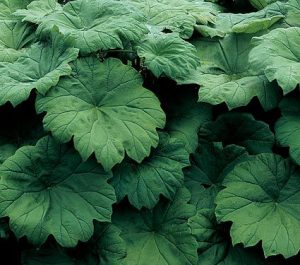
(http://www.whiteflowerfarm.com/24395-product.html)
Common name: shieldleaf rodgersia
family name: Saxifragaceae
Useful cultivars and selections:
USDA Hardiness Zone: 5-7
Mature height and spread:
height: 3-4feet
spread: 2-3feet
Form: low spread
Water use: medium
Soil requirements: Prefers moist, humusy, organically rich soils
Leaf arrangement: huge palm-like
Flower/Cone/Fruit description:Astilboides tabularis is noted for having large leaves somewhat resembling those ofRodgersia and upright flower spikes resembling those of Astilbe. It is valued by gardeners more for its unique foliage and architectural interest that for its flowers. Large, rounded, lobed, peltate leaves (to 2-3’ in diameter) on 2-3 foot tall petioles rising from the ground. Leaves have a shield-like appearance as reflected in the sometimes used common name of shield leaf. Leaves also have table-like surfaces, hence the species name. Tiny, astilbe-like white flowers form in panicles atop flowering stems that gracefully arch above the foliage in late spring.
Limitations:Watch for slugs. Foliage decline (leaves brown up) may occur in hot summers and/or periods of drought if soils are not kept moist or if plants are grown in too much sun.
suitable uses:Effective on pond or stream banks or landscape areas with consistently moist soils. May also be effective in woodland gardens and other moist but shaded areas.
2.Campanula latifolia
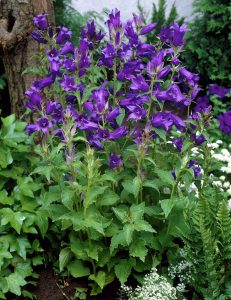
Campanula latifolia var. macrantha
(http://www.bing.com/images/results.aspx?q=Campanula%20latifolia&FORM=BIRE&fdr=lc)
Common name: broadleaf bellflower
family name: Campanulaceae
USDA Hardiness Zone: 4-8
Mature height and spread:
height: 3-4 feet
spread: 1.5-2 feet
Form: cone
Water use: medium
Soil requirements: average, medium, well-drained soil
Leaf arrangement: alternate
Flower/Cone/Fruit description:It is a clump-forming perennial that typically grows 3-4’ (less frequently to 5’) tall. Large, tubular, bell-like, purplish-blue flowers (to 2.5” long) appear in the upper leaf axils and in short terminal clusters (racemes) in early summer. Unbranched, hairy stems rise up from basal rosettes of ovate-oblong, toothed, stalked, hairy, medium green leaves (to 6” long). Leaves become smaller, narrower, pointed and eventually sessile as they go up the stems.
Limitations:Taller plants may need staking or other support. Can spread somewhat aggressively in the garden.
suitable uses:Best naturalized in open woodland areas, wild areas, cottage gardens or at the rear of borders. Group or mass for best effect. Considered somewhat coarse for a prominent location in the border.
3.Dicentra formosa
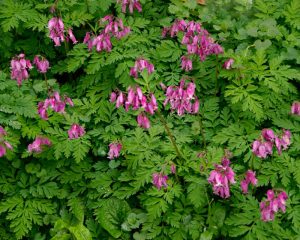
(http://gardensonline.com.au/gardenshed/plantfinder/Show_2254.aspx)
Common name: Pacific bleeding heart
family name: Papaveraceae
USDA Hardiness Zone: 5
Mature height and spread:
height: 0.1-0.5 m
spread: 0.5-1.0 m
Form: Clump-forming
Water use: medium
Soil requirements: average, medium, well-drained soil
Leaf arrangement: alternate
Flower/Cone/Fruit description:a spreading rhizomatous perennial with finely divided grey-green leaves and short racemes of nodding, deep crimson flowers in late spring and early summer
Limitations:All parts cause stomach ache if ingested, the foliage may aggravate skin allergies
suitable uses:Beds and Borders, Ground Covers
4.Iris latifolia
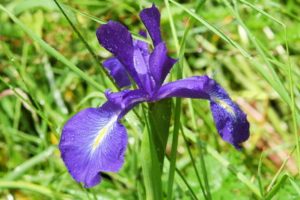
(http://www.kew.org/science-conservation/plants-fungi/iris-latifolia-english-iris)
Common name: English iris
family name: Iridaceae
USDA Hardiness Zone: 7
Mature height and spread:
height: 0.5-1 m
spread: 0-0.1 m
Form: bushy
Water use: medium
Soil requirements: average, medium, well-drained soil
Leaf arrangement: opposite
Flower/Cone/Fruit description:Iris may be rhizomatous or bulbous perennials, with narrowly leaves and erect stems bearing flowers with 3 large spreading or pendent fall petals, alternating with 3 erect, often smaller, standard petals, in late winter, spring or early summer
Limitations:
May be attacked by slugs and snails
May be subject to grey moulds and iink disease (iris diseases
suitable uses:Flower borders and beds City & Courtyard Gardens Coastal Cottage & Informal Garden
List 2
1.Anchusa azurea
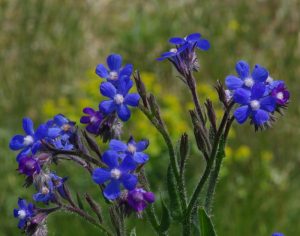
(https://anentangledbank.wordpress.com/2012/05/31/the-blues-anchusa-azurea-italian-bugloss/)
Common name: alkanet
family name: Boraginaceae
USDA Hardiness Zone: 3-8
Mature height and spread:
height: 1-3 m
spread: 1-1.5 m
Form: clump-forming
Water use: medium
Soil requirements: average, medium, well-drained soil
Leaf arrangement: opposite
Flower/Cone/Fruit description:a coarse, hairy, spring-blooming, clump-forming, short-lived perennial of the borage family that typically grows to 3-5’ tall. It is native to the Mediterranean but has been introduced in North America where it has escaped gardens and naturalized in British Columbia plus a number of States in the U.S. Alternate, entire, hispid, linear-elliptic to lanceolate leaves (to 6” long) are sessile or clasping at the base. Deep blue to violet flowers (to 3/4” diameter) are reminiscent of forget-me-nots (Myosotis). Flowers bloom in loose terminal spikes (scorpioid cymes) rising above the foliage in late spring to early summer.
Limitations:Crown rot can be a significant problem, particularly in wet, poorly drained soils. Taller plants usually need some kind of unobtrusive staking or support. Plant stems tend to open up and flop and foliage tends to depreciate in summer after bloom, particularly in hot and humid summer climates such as the St. Louis area.
suitable uses:Borders. Specimen or small groups. Naturalized areas.
2.Cephalaria gigantea
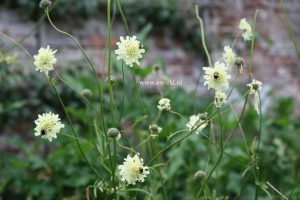
(http://www.esveld.nl/htmldiaen/c/cegiga.htm)
Common name: giant scabious
family name: Caprifoliaceae
USDA Hardiness Zone: 3-7
Mature height and spread:
height: 4-6 m
spread: 2-4 m
Form: clump-forming
Water use: medium
Soil requirements: average, medium, well-drained soil
Flower/Cone/Fruit description: It is an erect, clump-forming perennial that typically grows 4- 6’ (infrequently to 8’) tall. Scabiosa-like primrose yellow flowers (to 2.5” diameter) bloom in summer. Flowers appear singly atop stiff, wiry, branched, sparsely-leaved stems rising well above the foliage mound to 6’ tall. Pinnately-divided, dark green, basal leaves (to 16” long) with oblong to lance-shaped segments.
Limitations:Taller plants may need some staking or support.
suitable uses:This plant needs a large space. Border rears or cottage gardens. Naturalize in wildflower meadows or wild areas.
3.Lychnis coronaria
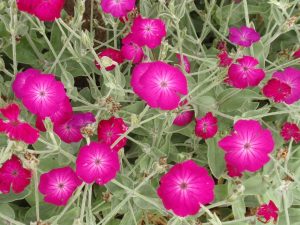
OLYMPUS DIGITAL CAMERA
(http://www.aboutgardendesign.com/plant-guide/item/lychnis-coronaria)
Common name: rose campion
family name: Caryophyllaceae
USDA Hardiness Zone: 4-8
Mature height and spread:
height: 2-3 m
spread: 1-1.5 m
Form: clump-forming
Water use: medium
Soil requirements: average, medium, well-drained soil
Flower/Cone/Fruit description: Rose campion is a clump-forming perennial which is perhaps grown as much for its basal clumps of ovate, densely woolly, silver-gray leaves (to 5″ long) as for its 5-petaled, vivid rose magenta flowers (to 1″ diameter). Flowers bloom profusely on smaller-leafed, gray stems rising 2-3′ tall. Lengthy late spring to early summer bloom period.
suitable uses:Leaves and flowers provide excellent color and contrast to perennial borders, wild gardens, cottage gardens or meadows. May be used as an accent or specimen plant.
4.Lathyrus latifolius
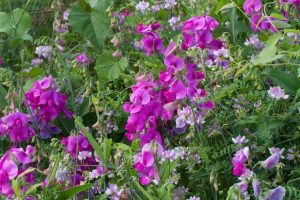
(http://macgardens.org/?cat=3&paged=2)
Common name: perennial pea
family name: Fabaceae
USDA Hardiness Zone: 3-8
Mature height and spread:
height: 6-9 m
spread: 3-6 m
Form: long-lived perennial with trailing or climbing stems
Water use: medium
Soil requirements: average, medium, well-drained soil
Flower/Cone/Fruit description: Broadly-winged plant stems clad with oval, medium green, 3-inch leaflets in pairs will ramble indefinitely along the ground (foliage to 4-8″ tall) or climb by tendrils up nearby vegetation or support structures to 6-9′ tall. Showy flowers (each to 1″ across) in colors of rose, pink-purple or white bloom early summer to fall in racemes of 6-11 flowers. Flowers are not fragrant. Flowers give way to flattened, pea-like seed pods. Both pods and seeds are toxic if ingested. Lathyrus comes from the Greek word for pea. The specific epithet means broad-leaved. Additional common names for this species include perennial pea and wild sweet pea.
limitations: Additional potential pests include aphids, pea moth and mites. Potential diseases include powdery mildew, gray mold, rust, black root rot and leaf spot.
suitable uses:Plants will sprawl along the ground or twine onto support structures. Borders or cottage gardens. Ground cover for slopes and embankments. Trail over rocky areas. Climb on walls or fences. Containers.